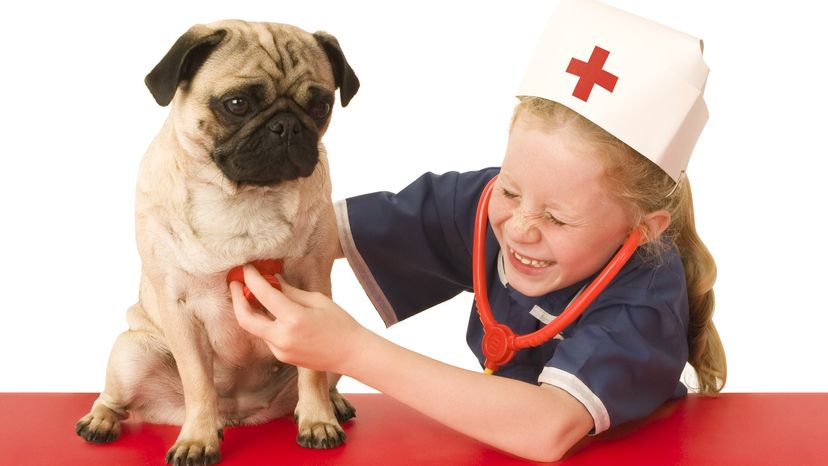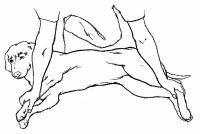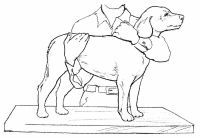 “Playing Vet with your dog? MrPliskim / Getty Images
“Playing Vet with your dog? MrPliskim / Getty Images
Have you ever seen a dog injured in a fight or hit by a car? Perhaps you could only shake your head and walk away. Not because you didn’t care, but because you didn’t know how to approach and examine the dog or what to do next. Especially if you have a dog of your own, you’ll want to be prepared, for your dog depends on you for help in an emergency situation.
This article will give you the information and techniques you’ll need to confidently administer first aid and perhaps save the life of a pet. From administering CPR to treating an insect bite, you’ll learn how to deal with a wide range of dog emergencies.
Let’s begin by learning how to properly restrain a hurt and frightened dog, since this will be the first order of business to treat most dog injuries.
Restraining an Injured Dog
An injured dog is usually frightened and in pain, and unless it feels very secure with your presence, it may try to escape or even bite you. So, it’s important to use the following tips when approaching an injured dog.
Step 1: Approach the dog slowly, speaking in a reassuring tone of voice.
Step 2: Move close to the dog without touching it.
Step 3: Stoop down to the dog. While continuing to speak, observe its eyes and facial expression.
Step 3a: If the dog is wide-eyed and growling, DO NOT attempt to pet it. Proceed to Step 4.
Step 3b: If the dog is shivering, with its head lowered and a "smiling" appearance to its mouth, pet the dog for reassurance, first under the jaw. If this is permitted, pet the dog on the head.
Step 4: Slip a leash around the dog’s neck. Use whatever material is available — a rope, a tie, a belt, or torn rags.
Step 5: If you are alone, place the leash around a fixed object, such as a fence post. Pull the dog against this object and tie the leash so the dog cannot move its head.
Step 6: Muzzle the dog to protect yourself.
Step 6a: Using a long piece of rope, torn rags, or a tie, loop over the dog’s muzzle and tie a single knot under the chin.
Step 6b: Bring the ends of the rope, rags, or tie behind the ears and tie them in a bow.
Step 7: If you are alone, proceed to administer treatment.
If You Have an Assistant
Step 8: If possible, place the dog on a table or other raised surface.
Step 8a: If the dog is small, grasp its collar with one hand, and place your other arm over its back and around its body. At the same time, pull forward on the collar and lift the dog’s body, cradling it against your body.
Step 8b: If the dog is large, slip one arm under its neck, holding its throat in the crook of your arm. Be sure the dog can breathe easily. Place your other arm under the dog’s stomach. Lift with both arms.
Step 8c: If the dog is very large, slip one arm under its neck, holding its chest in the crook of your arm. Be sure the dog can breathe easily. Place your other arm under the dog’s rump and, pressing your arms toward one another, lift the dog.
Step 8d: Have your assistant administer treatment while you hold the dog on the table.
Step 9: If you want the dog on its side:
Step 9a: Stand or kneel so the dog is in front of you with its head to your right.
Step 9b: Reach over the dog’s back and grasp the front leg closest to you with your right hand and the rear leg closest to you with your left hand.
Step 9c: Push the dog’s legs away from you, and slide the dog down your body.
Step 9d: Grasp both front legs in your right hand and both rear legs in your left hand.
 “©2006 Publications International, Ltd.Steps 9d and 9e
“©2006 Publications International, Ltd.Steps 9d and 9e
Step 9e: Hold the dog’s neck down gently with your right arm.
Step 9f: Have your assistant administer treatment.
Step 10: If you want the dog sitting:
Step 10a: Slip one arm under the dog’s neck, holding its throat in the crook of your arm. Be sure the dog can breathe easily.
Step 10b: Place your other arm over the dog’s back and around its stomach.
Step 10c: Pressing the dog against your body, apply body weight to the dog’s rear quarters.
Step 10d: Have your assistant administer treatment.
Step 11: If you want the dog standing:
 “©2006 Publications International, Ltd.Steps 11a and 11b
“©2006 Publications International, Ltd.Steps 11a and 11b
Step 11a: Slip one arm under the dog’s neck, holding its throat in the crook of your arm. Be sure the dog can breathe easily.
Step 11b: Place your other arm under the dog’s stomach.
Step 11c: Press the dog toward your body and lift upward.
Step 11d: Have your assistant administer treatment.
Learning how to restrain a dog will help you in almost any pet emergency situation. Now let’s take a look at how to transport that injured dog to the veterinarian.
First-Aid Kit Essentials
Pet owners should have the following items on hand for dog emergencies.
- Adhesive tape
- Gauze bandages and gauze pads
- Scissors
- Strips of clean cloth
- Safety pins
- Wooden ruler or tongue depressor for tourniquet
- Wooden paint-mixing sticks for splints
- Hydrocortisone cream
- Muzzle
- Rectal thermometer
- 3% hydrogen peroxide
- Saline eyewash
- Fresh bottled water
- Diphenhydramine (Benadryl)
- Blankets and towels
- Nylon rope for restraint
- Wire cutters
- Pliers
- Cotton batting
- Tweezers
- Leash
Read More

